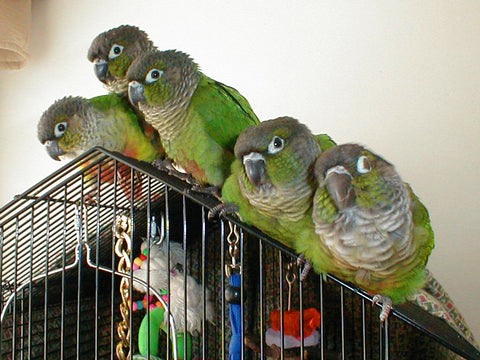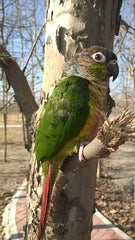Green Cheek Conure (Parakeet) Species Guide: Pet Parrot Care, Lifespan, Personality & Price
Built with a small finger-perfect frame, green-cheeked conures are wonderful birds that are fun to spend time with as pets.
I emphasized spending time because green cheek conures require a lot of attention.
So, if you didn’t know that, there’s probably a whole lot more you don’t know about these adorable birds...
That said, this article will be a detailed guide about what you need to know about the green cheek conure as a prospective owner.

Green-Cheeked Conure Aliases
To know a bird better, the least you can do is to know its other names right?
That said, the Green Cheek Conure is also known as a yellow-sided parrot, green cheeked parakeet or green cheeked parrot. It is popular among Americans as a parakeet, but referred to as conure elsewhere.
Scientific Name
The species of the green cheeked conure is scientifically called Pyrrhura molinae and is further grouped into six (6) subspecies:
- P. molinae australis
- P. m. flavoptera
- P. m. hypoxantha
- P. m. molinae
- P. m. restricta
- P. m. phoenicura
The ones you are more likely to find in your pet store are P. m. molinae, P. m. australis, and P. m. restricta.
Green Cheek Conure Bio Data
The green-cheeked parakeet is an exotic species native to South America and Central America. More specifically, in the woodlands and forests areas of Brazil, Argentina and Paraguay and Bolivia.
Of all the conures, the green cheek conure is the most common as a pet bird with its affectionate and subtle personality.
Physical Appearance
As a pint-sized bird, an adult green cheeked conure only reaches 10 inches, and weighs about 60g to 80g at full size.
Though not as colourful as jenday or sun conures, it’s still a sight to behold. It is typically green, with a dark-colored crown, white eye rings, green cheeks, a grayish beak and bright maroon on its pointed tail. Its flight is cobalt blue and a tint of maroon on its chest.
Unlike other pet birds, both male and female have identical color markings.
Needless to say, it is a stout and compact bird and fits well on its owner’s fingers.

Green-Cheeked Parakeet Personality
Without any doubt, a green cheek conure is a loving and playful bird. They bond pretty well with their owners and are not as loud or destructive as their cousins – dusty conure or peach front conure.
Which begs the question:
Are you willing to spend as much time as it wants with you?
As a highly social and affectionate bird, it isn’t suitable to be kept in a cage alone all through the day. It needs to interact with its owner and have an out of cage time regularly. More so, they enjoy daily routines like feeding or lights out time and will give off cries if you break them.
To some people, the green cheeked conure is a high maintenance pet. If you don’t have the time to satisfy its yearnings for attention or make regular trips down to the vet, then yes. Asides that, it chews a lot and can become destructive if you don’t provide it with foraging toys.
But if you have time, you can be sure to have a great feathered friend for years to come.
For one, it can learn a lot of tricks like hanging upside down, answering commands, waving, kissing, lying on its back and even potty training.
Green-Cheeked Conure Vocal Ability
First off, a green cheek conure is an intelligent bird, but can only learn a few words. In fact, it’s one of the quietest parrots and yet again doesn’t mean it doesn’t make a great deal of noise.
Its deep and low voice makes it words, if it speaks any, unclear.
Regardless of its not-so-good speaking prowess, its sweet personality makes up for what it doesn’t have in speech to make it an ideal pet bird.
Do they make too much noise for you? See how well you handle the screeches in the video below:
Providing Shelter For Your Green Cheek Conure
A green cheek conure would thrive at room temperature between 65 to 80°F.
For its housing, the standard conure cage measurement is 18x18x24 inches with a metal mesh with ½ inch spacing.
In the case the bird will be left alone for longer periods or has a companion, the cage has to be made larger for obvious reasons.
Also, multiple perches at least 9 inches long and ½ thick should be placed strategically alongside food cups in the cage to keep your bird in good shape.
Not to mention you have to provide foraging toys not only as play toys but also to keep it at bay from chewing on anything that crosses its path.
Last but not least, a metal grate should be placed over the droppings tray to prevent any contamination
Note: Don’t keep different species of birds together. And green cheek conures kept in pairs may bond with each other more than with their owners.
Good Care For Your Green-Cheeked Conure
As you already know, a green cheek needs to be cared for a great deal. Here are some inevitable practices you should be doing the right way for your pint-sized feathery friend.
Feeding
A well-balanced diet consisting of specialized pellets, fresh fruits and vegetables should be available at all times. As a matter of fact, vegetables and fruits not eaten within a few hours should be thrown out. Some of their favorites are apples, strawberries, spinach beets and broccoli.
Also, you can give your feather friend a treat with plain yogurt, American cheese or boiled meat. But this should be done sparingly. Actually, including in not more than 10 percent of its diet is ideal.
You should never feed a green cheek avocado, caffeine, sugar, chocolate or fruit seeds. Try to avoid sugar, and high fat treats as well.
Its water should be clean, filtered and free of chlorine or any chemicals. You also have to change it daily.
Bathing
A green cheek parakeet loves to bath and is good for you as well to have a well-groomed bird. Provide clean, chlorine-free water in a shallow bowl every other day for bathing.
Alternatively, especially in the case that your bird doesn’t bathe itself, mist him down with water in a clear spray bottle.
Learn how to properly bathe your birdie from the video below:
Exercise
In the wild, green cheeks fly for miles to find food and water. While this can’t be exactly replicated in captivity, providing some play toys and regular out of cage time can help your feather friend stay healthy and active.
Grooming
These grooming practices should be done by an avian or vet to prevent any injury to your green cheek conure.
- Clip its flight feathers to prevent escape or injury to itself
- Trim its nails as soon as they are sharp to prevent injury to yourself or the bird. You can as well place some rough patches in the cage to prevent this altogether.
In the end, how well you care for your bird will go a long way in determining how long it will live.
How Long Do Green Conures Live?
Their average lifespan in captivity is about 15 years but is cut to 10 years if they are left alone. With proper care and attention, they can for up to 30 years.
Possible Health Issues
Green cheeks will molt sometime in autumn to replace feathers damaged during the year. So, it shouldn’t be a cause for alarm except you keep your pet alone (neglect), or it has become bored.
Be that as it may, some behaviors and symptoms mean your feather friend may be at risk, such as:
- Beak swelling or accumulations
- Fluffed up or messy feathers
- Sitting on the cage floor
- Coughing
- Discolored or watery stools
- Favoring one foot when not sleeping
- Nasal discharge
- Eye discharge and other eye issues like redness or inflammation
- Appetite loss
If you discover any of these symptoms, you are best off to have your bird checked by an avian or veterinarian.

Green Cheek Conure Price
The average price for a green cheek conure is around $375, can get one for as low as $250 or high as $500. Its price tag continues to soar with exquisite breeds like Yellow Sided and Pineapple conures.
Another thing is, the age of a green cheek conure affects its price. For instance, an adult green cheek will not cost as much as one that has just been weaned.
Finally, the price for the birds excludes expense spent its cage and toys which will also cost several hundred dollars.
Is A Green Cheek Conure Right For You?
No doubt, they are an adorable and intelligent bird that will bond well with you as a feathered friend.
But this is only true as long as you have the time to interact with her regularly and satisfy her many needs.
If you do, then getting a green cheeked conure is the beginning of a long-lasting relationship with your pet.

I have a green cheek named Cricket and he is very vocal. I know a lot of websites and “professionals” say that they don’t tend to speak, but he has a pretty extensive vocab and repratoire of sounds. He says “Cricket, Mama, Love you, NO!”, and an occasional explative when he gets all in his feelings. He says “Miss you” and whistles a lot i.e. in the movies when a man thinks a woman is pretty. He also laughs a LOT. And he uses all of this in context. For example, I came home from vacation and he jumped on me, made several kissy noises then said “Mama…miss you” more kissy noises. He’ll cuddle me and say “Love you” he’s very emotional and amazing. He’s so sweet. I never knew I could love a bird as much as my own kids. Definitely my “feather baby”